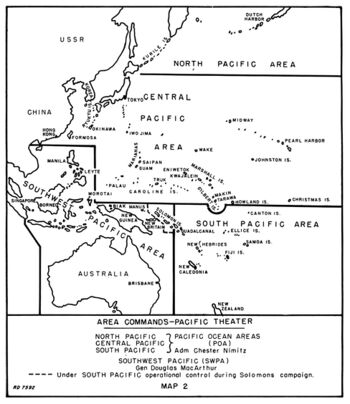Southwest Pacific Area: Difference between revisions
Jump to navigation
Jump to search


imported>Russell D. Jones ("South through Alaska?" It must have been a long day on CZ ....) |
Pat Palmer (talk | contribs) m (Text replacement - "U.S. Navy" to "United States Navy") |
||
| (4 intermediate revisions by 2 users not shown) | |||
| Line 1: | Line 1: | ||
{{subpages}} | {{subpages}} | ||
[[Image:Ww2-pacific-theater.jpg| | [[Image:Ww2-pacific-theater.jpg|thumb|right|350px|Map of the theater of operations in the Pacific Ocean and East Asia during the [[Second World War]]. Charles W. Boggs Jr., ''[http://ibiblio.org/hyperwar/USMC/USMC-M-AvPhil/USMC-M-AvPhil-1.html Marine Aviation in Philippines]'' (Washington: Historical Division, Headquarters, U.S. Marine Corps, 1951), 2. ]] | ||
The '''Southwest Pacific Area (SWPA)''' was a [[World War II]] [[theater of operations]] under the command of [[General of the Army]] [[Douglas MacArthur]] that extended from the [[Philippines]] south through [[New Guinea]] and [[ | The '''Southwest Pacific Area (SWPA)''' was a [[World War II]] [[theater of operations]] under the command of [[General of the Army]] [[Douglas MacArthur]] that extended from the [[Philippines]] south through [[New Guinea]] and [[Australia]], and west to [[Singapore]]. Its eastern border included parts of the [[Solomons Islands]]. | ||
The existence of the area, to some extent, reflected the original Japanese barrier between Hawaii and Australia, but also reflected the interservice rivalries between the [[U.S. Army]] and [[ | The existence of the area, to some extent, reflected the original Japanese barrier between Hawaii and Australia, but also reflected the interservice rivalries between the [[U.S. Army]] and [[United States Navy]], and the ego of MacArthur. | ||
Australian forces in the theater were subordinated to the SWPA headquarters, although Australia still commanded its troops in the Mediterranean. | Australian forces in the theater were subordinated to the SWPA headquarters, although Australia still commanded its troops in the Mediterranean. | ||
==Command staff== | ==Command staff and support organizations== | ||
*Chief of Staff, General [[Richard Sutherland]] | *Chief of Staff, General [[Richard Sutherland]] | ||
*Intelligence | *Deputy Chief of Staff for Intelligence (G-2), Major General [[Charles Willoughby]] | ||
**[[Allied Intelligence Bureau, Southwest Pacific Area]] | |||
*Chief Signal Officer, Major General [[S. B. Akin]] | |||
**[[Central Bureau, Southwest Pacific Area]] | |||
**[[Fleet Radio Unit, Melbourne]] | |||
==Major components== | ==Major components== | ||
*[[United States Seventh Fleet]] under Admiral [[Thomas Kinkaid]] | *[[United States Seventh Fleet]] under Admiral [[Thomas Kinkaid]] | ||
* | *Far East Air Forces under General [[George Kenney]] | ||
*[[Sixth United States Army]] commanded by General [[Walter Krueger]] | *[[Sixth United States Army]] commanded by General [[Walter Krueger]] | ||
*[[Eighth United States Army]] led by General [[Robert Eichelberger]] | *[[Eighth United States Army]] led by General [[Robert Eichelberger]] | ||
Latest revision as of 10:05, 10 February 2023

Map of the theater of operations in the Pacific Ocean and East Asia during the Second World War. Charles W. Boggs Jr., Marine Aviation in Philippines (Washington: Historical Division, Headquarters, U.S. Marine Corps, 1951), 2.
The Southwest Pacific Area (SWPA) was a World War II theater of operations under the command of General of the Army Douglas MacArthur that extended from the Philippines south through New Guinea and Australia, and west to Singapore. Its eastern border included parts of the Solomons Islands.
The existence of the area, to some extent, reflected the original Japanese barrier between Hawaii and Australia, but also reflected the interservice rivalries between the U.S. Army and United States Navy, and the ego of MacArthur.
Australian forces in the theater were subordinated to the SWPA headquarters, although Australia still commanded its troops in the Mediterranean.
Command staff and support organizations
- Chief of Staff, General Richard Sutherland
- Deputy Chief of Staff for Intelligence (G-2), Major General Charles Willoughby
- Chief Signal Officer, Major General S. B. Akin
Major components
- United States Seventh Fleet under Admiral Thomas Kinkaid
- Far East Air Forces under General George Kenney
- Sixth United States Army commanded by General Walter Krueger
- Eighth United States Army led by General Robert Eichelberger